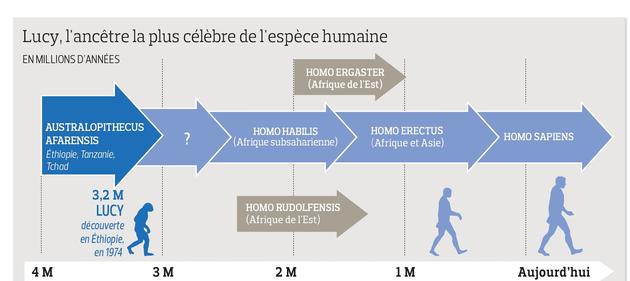INFOGRAPHIE – At the scanner, the fossil Australopithecus shows traces of fractures, signs of a fall from a great height
Lucy, the most famous human ancestors, had apparently not cut all ties with his ancestors monkeys and even spent time climbing trees, d According to a US study published Monday in the British journal Nature . A practice that would have even caused her death, due to a fall from high branches.
The small Australopithecus (1.10 m for 29 kg) may well have been discovered there over forty years, in 1974 in Hadar in Ethiopia by a scientific team with the French and Maurice Taieb Yves Coppens, his bones still have many things to teach us. And especially when one uses the most modern technologies, such as researchers led by anthropologist John Kappelman of the University of Texas at Austin.

Click here to enlarge the graphic
scientists Americans have enjoyed a very rare trips fossil Lucy, preserved as a national treasure by the museum in Addis Ababa in Ethiopia. From 2007 to 2013, several major American museums have paid for gold the right to expose the real remains, complete with a little less than 40%, the most famous representative of the Australopithecus afarensis. During his time in Austin, researchers with the agreement of Addis Ababa, have passed all Lucy’s bones in a micro X-ray scanner, which allows 3D detailing inside with fossil much better than medical devices resolution. The operation took not less than 10 days and produced 35,000 cuts X-ray of the skeleton. Precision helping to make the autopsy of Australopithecus, 3.2 million years after his death in Ethiopian lowlands. “Lucy is precious. There is only Lucy, and we want to study as well as possible, “says Richard Ketcham, professor of geology at the University of Texas at Austin and co-author of the study. “With the scanner, you can see the heart of the fossil, the details and internal structures in the bones.”
And it is this precise approach that allowed researchers to detect unusual fracture in fossil. The end of the right humerus (upper arm bone attached to the shoulder) was broken, not frank and straight way as sometimes happens on fossilized bones, but with a series of small sharp fractures, accompanied fragments and splinters of bone still in place.

anthropologist John Kappelma, University of Austin (Texas), holding a 3D reproduction of Lucy’s bones . Copyright: MMiller /
“C is a compression fracture occurs when the hand touches the ground after a fall, which projects the shoulder elements against each other and produced this kind of unique signature on the humerus, “explains John Kappelman. The American anthropologist is not a specialist in this type of injury, but he took advantage of the expertise of Dr. Stephen Pearce, an orthopedic surgeon in Austin, which found the wound on a 3D reconstruction of Lucy’s bones. To complete the picture, the researchers also detected other fractures, less severe, to the other shoulder, right ankle, the knee and the left pelvis. A clinical picture consistent with a fall from a great height, which could cause fatal damage to internal organs. Lucy would be dropped from a height of at least 12 meters, almost 60 km / h. His feet had to touch the ground first, projecting forward. His wound to the humerus also shows that she must be conscious during his fall, and tried to protect themselves by putting his arms forward.
“This study provides a new answer to an old scientific debate that has been the discovery of Lucy: she was clearly bipedal, but she had still an arboreal behavior? His falling tree proves that this was probably the case “
” This is a very interesting study, which brings us a new and very convincing look, richer than strict anatomical study on the life of Lucy and her last moments, “said Jean-Jacques Hublin, director of the department of human evolution at the Max Planck Institute in Leipzig and Professor of the international Chair of paleoanthropology at the College de France. “Especially this study provides a new answer to an old scientific debate that has been the discovery of Lucy: she was clearly bipedal, but she had still an arboreal behavior? His falling tree proves that this was probably the case. “Even if it were to find most of their food near the ground, she had to find an advantage to climb, perhaps to shelter predators at night.
“I welcome this beautiful study says Yves Coppens, who was one of the discoverers of Lucy in 1974. the Americans did a great job, and I ‘ admit that they respond to a question, how Lucy is dead, to which we never thought the student forty years ago! “Against the initial advice of many of his American colleagues, Yves Coppens has long championed the idea that Lucy combined both arboreal bipedalism with a behavior. A compromise not ideal from an anatomical point of view. “It worked less well than those who succeeded him and had to climb less well than those that preceded it, and unfortunately it is perhaps because of this that she fell,” says Yves Coppens.
No comments:
Post a Comment